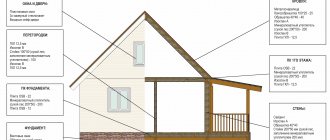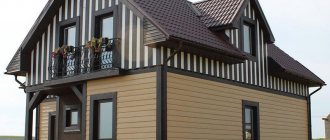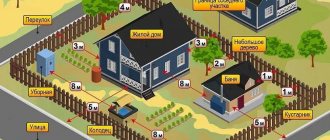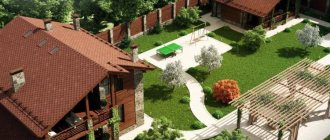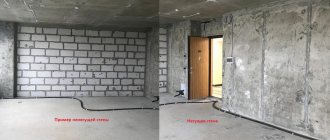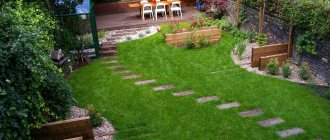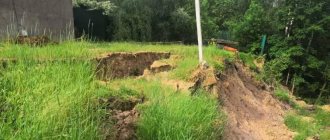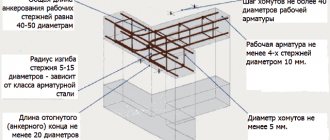Home / Family lawyer / Is it allowed to build a house on a plot of 3 acres
The planning and development of the territories of gardening (dacha) citizen associations is regulated by SNiP 30−02−97. According to clause 6.7 of SNiP 30−02−97, the minimum distances to the border of the neighboring plot for sanitary conditions should be: from a residential building (or house) - 3 m; from buildings for keeping small livestock and poultry - 4 m; from other buildings - 1 m.
The construction of an object on a land plot must be carried out in accordance with the town planning plan of the land plot, which indicates the minimum setbacks from the boundaries of the land plot to capital construction objects on the basis of the town planning regulations adopted by the local government body for the territorial zone within which the given land plot is located.
House on a plot of 3 acres. Construction of houses on three acres of land
Building a house on 4 acres seems like a completely impossible mission, but it’s not.
In such an area, it is very important to make accurate calculations and also decide how many rooms you need for a comfortable stay indoors. Is it possible to erect a building for permanent residence of residents? This is a real task, but it is very important to choose the right type of construction. In our article we will consider all the nuances of the project for such a plot area. In order for the building to create as comfortable conditions as possible, you need to adhere to certain norms and rules.
For a plot of three acres, you need to position the building correctly. In order for the building to create as comfortable conditions as possible, you need to adhere to certain norms and rules. Namely:
- The first criterion is the terrain features;
- The second is a characteristic of the orientation of the area of the site.
Where there is more sun, it is better to set aside a place for planting trees and possibly designing a landscape. In darker areas of the area, you can place ornamental shrubs or barbecues. There is an old Russian habit according to which the house is placed with the front part facing the road. It is worth noting that this design makes it possible to create an intimate and cozy courtyard.
Minimum land area for individual housing construction
If you do not have accurate data on the parameters of the land plot, but you need to obtain this data for construction planning, you can make the calculation yourself. To do this, you can use a universal calculator. Take into account the fact that you must have clearly defined boundaries of the land plot.
How to correctly calculate and find out the size of the land. plot?
If the area is small, adhere to the principle of saving space and arrange objects without violating the rules, but with maximum space conservation. The best solution in planning a building is to turn to professionals who have extensive experience in arranging private areas. They will provide you with a ready-made project that can be implemented once you receive all the documents.
If a citizen took a plot of land for free use to engage in farming or personal subsidiary farming for a period of no more than 6 years (Clause 6, Part 2, Article 39.10 of the Land Code of the Russian Federation) - after 5 years; If a citizen has taken a plot of land for free use for the construction of individual housing, or for running a subsidiary farm for a period of no more than 6 years (clause
How to locate a house on a 4-acre plot. Landscape design of a plot of 4 acres: selection of garden objects
In a small summer cottage it is easier to create a cozy atmosphere. A miniature area is easier to maintain in order; it does not require much time or money to improve it. But to create a landscape design for a 4-acre plot, clear planning is necessary, because even a small garden should be beautiful, functional and have a finished look.
Features of the layout of a small area
Owners of a small summer cottage should soberly evaluate what they have and find a balance between the desire to embrace the immensity and the possibilities of a small area. It is advisable to divide the site into zones in advance, determine a place for a house, a bathhouse, parking for vehicles, a garden and a vegetable garden.
The main object will be a residential building, and taking into account its location, places for lawns, flower beds, planting trees and shrubs are selected. You should not clutter up the area with buildings or create huge flower beds. It is necessary to select the objects that are really necessary and place them correctly on the site.
Selection of garden objects
The distribution of objects when arranging the landscape design of a dacha plot of 5 acres has its own characteristics. In a small area it is necessary to place everything for comfortable rest and work. In addition to the house, important components of garden design are the following objects:
- Paths. It is desirable that the paths on the 4-acre plot be winding. Straight lines visually conceal an already small space.
- Fencing. Fences in a small area should not be bulky. Small decorative fences that will fit into the overall style direction are enough.
- Flower beds, flower beds. It is important to choose low plants that will not block small architectural objects and other garden crops. You can combine several elements at once. For example, add a small pond or cascade, a fountain, or a water mill to an alpine slide.
- Trees, shrubs. When choosing shrubs, it is necessary to take into account their size in adulthood. Otherwise, instead of a cozy corner, you may end up with impenetrable jungle. It is better to choose low-growing species and not fill the entire area with them, but allocate a small area for them.
There should not be many architectural buildings in a small area, but it is desirable that they have an interesting shape. Preference should be given to multifunctional objects.
Space Saving Tips
A miniature garden can look larger if it is arranged according to all the rules. Techniques that expand the space and distract the eye from its small size:
- Vertical gardening . To create additional space, horizontal shelves, pots or any containers mounted on the wall of the house are used. Plants for planting must be selected carefully. Curly and ampelous forms are ideal. Using portable flowerpots and baskets, you can create several tiers of landscaping at the entrance to the house, a gazebo, and decorate the walls.
- "Beds" on the wall. Such exotic beds can be attached to the facade of the house, pillars, fences. They take up absolutely no space on the site, and to create them you can take ordinary wooden boxes. Most often they are used for planting flowers, growing strawberries or herbs.
- Mobile garden. An original idea could be all kinds of forms for planting flowers (vases, amphorae), car tires, multi-tiered structures made of bricks, boards, plastic boxes. Modular beds can be an excellent solution if the soil on the site is not suitable for the crops that inquisitive gardeners want to grow in their garden. Compact containers can be filled with purchased soil and the problem will be solved.
But the main advantage of vertical and modular beds is the enormous space savings on a small summer cottage.
For vertical gardening, you can use a variety of plants, but hanging varieties are best suited.
Plants for hanging and portable modular containers:
- ampelous begonia;
- marine lobularia;
- nasturtium;
- lobelia erinus;
- petunia cascade;
- purslane;
- bacopa;
- dichondra;
- pelargonium ivy leaf.
Some vegetables (cucumbers, beans, peas) and herbs can be planted in vertical structures.
It must be taken into account that plants located at heights and in containers experience a lack of moisture in the heat. The less soil in the pot, the more often it dries out. Also, soil in containers quickly depletes; it needs to be fed once a month.
Landscape design of 4 acres of garden can be decorated with love and imagination and embody extraordinary design solutions in it.
What plants to choose and their planting rules
The choice of plants depends on soil type, lighting conditions and soil moisture. Regardless of the size of the garden, these factors need to be taken into account.
Learn how to landscape your front garden.
The plant selection algorithm suggests the following recommendations:
- Estimate the amount of available space in your sketch. Study plant catalogs, paying attention to the size of adult specimens and the conditions they need to thrive.
- Based on the acidity level of the soil . Typically, growing plants absorb nutrients by leaching the soil, causing it to become moderately acidic. Most plants need neutral, slightly acidic or slightly alkaline soil.
- Pay attention to the orientation of the site according to the cardinal points. Hydrangeas, hostas, and magnolias grow well on the north side. In the south - ornamental grasses, pelargoniums, lavender, poppies. The western section is the most advantageous - there is enough light in the first half of the day and no bright sun rays in the second half, when the air is warmed up to its maximum. These conditions are suitable for most crops - peonies, roses, spirea, viburnum.
- To plant the “foot” of shrubs, use plants with a dense crown: hostas, ferns.
- Trees absorb a lot of water, so planning to plant other crops under them is not recommended.
- There are many more plants that love the sun than those that grow in the shade. That's why use shaded areas to place outbuildings. Also note that crops such as roses, geraniums, verbenas, sage and lavender are completely shade intolerant.
- Group crops of three or five varieties to create a flower bed. Plants can be planted in open ground or in decorated pots.
- To prevent the garden from looking bare in winter, consider planting coniferous shrubs or trees. In nurseries there is a wide selection of their varieties of different shapes, sizes and shades.
- In spring, after a long winter, I want to see bright colors, so consider planting spring bulbous flowers - primroses, tulips, hyacinths.
- If you can't devote enough time to watering, choose succulents or pelargoniums. They tolerate temporary drought well.
- If you are new to gardening, do not choose roses for planting. They are the most demanding of all flowers and can react negatively to the lack of watering, timely fertilization and disease prevention.
We recommend you learn how to beautifully plant tulips and daffodils on your site.
Project of a two-story house on 4 acres. Second (attic) floor:
House on 4 acres, project.
After receiving the project, it was possible to build and begin building the foundation, which was a slab.
For its construction, Andrei invited three free builders who worked for his friend. At that time there was a change house on the site. The guys offered to completely break it, but Andrey did not allow this to be done, but decided to move it with the help of logs and a hydraulic jack. The building was assembled from a shaggy inch and covered with roofing felt in one layer. The change house survived the move with dignity, without major losses, even the roof remained intact and does not leak in the rain.
On May 30, workers began completely excavating the soil for the slab. The soil on the site consists of a soil layer of 40*60cm. and Cambrian clay. To remove the land, he bought a construction wheelbarrow, which he assembled with grief in half, but the whole point was that all the spare parts were from different models. The trough is from one, the wheel is from another, the frame tubes are from a third, but in the end I drilled it here and there, bent it here and there... The car, stiff and lame, began to fulfill its duties.
Alexander poured gravel onto the clay foundation of the pit and compacted it with a vibrating plate. On top I put 100mm of extruded PPS in two layers, and completely covered it all with film. I made reinforcement on top of it. On the sides of the slab body there is one layer (50mm) of EPS.
Andrey was confused by the formwork of the foundation, but the workers unanimously assured that it was possible - it would withstand the tank!
Recommendations for proper site planning
To conclude the article, here are some tips for optimal site planning:
Everything you plan to build on the site must be discussed with the whole family. This will help avoid conflict situations. Ideally, after creating a virtual plan, all household members go to an empty plot. Pegs with stretched ropes or stones mark the locations (building spots) of planned buildings. This is a house, garage, bathhouse, utility block, workshop, greenhouse, vegetable garden, lawn, etc. Paths are marked with sand or spray paint so that you can walk along them from one object to another and understand in situ whether it is convenient or not. Next, in brainstorming mode, the optimal site layout options are selected and finally approved.
A lawn is not a way to fill empty spaces on a site, but a separate independent element. We remember that the more bushes, trees and objects that are difficult to mow are planted on the lawn, the more difficult it is to care for and maintain the grass in beautiful condition.
The paths to the house can be made straight or more decorative - curved. We remember that in pursuit of design delights we should not forget about functionality and that the shortest distance is a straight line. If a person has to walk from home to a shed or greenhouse along an elaborate and too curved path, then most likely he will take a shortcut and end up going straight.
It is important to maintain the optimal distance from the house to the road in order to create a buffer zone for planting trees or shrubs in the entrance area. Green spaces will protect the site and the house from dust, noise, prying eyes and create a private area
When choosing a place to build a playground, we remember that children need constant supervision. Therefore, the play area should be located next to the house and clearly visible from the windows of the cottage, for example, from the kitchen, even while the hostess is preparing dinner.
A recreation area with a bathhouse, a gazebo and a barbecue is mainly located behind the house, in the so-called. private part, which is separated by the cottage from the entrance area.
Before building a gazebo, we think about how often it will be used. In many cases, it is optimal to arrange a spacious terrace or veranda at the back of the house for a pleasant pastime and evening tea parties. This is more rational than running with dishes and food from home to the gazebo and back. Or, if your soul requires it, it is better to build a full-fledged closed gazebo with a kitchen and utilities - water supply and electricity.
Architectural and finishing solutions for the house and buildings on the site must be in harmony with each other. For example, if the house is finished with brick or plastered, and the roof is covered with soft tiles, then the garage should match this style.
We recommend articles on the topic: How to register in a country house and change the category of land and the type of permitted use, How to buy the “right” country plot and defend your right to country infrastructure, Is it possible to cut down trees on your plot and How to inexpensively arrange access roads to the site.
How much is a plot of 3 acres? How many square meters in 1, 10, 100, 1000 acres: table
However, for a person who rarely encounters specific calculation information, and land accounting measures are far from colloquial concepts, it is not at all difficult to make a mistake. Moreover, many people think that the word weaving is an outdated concept, unlike, for example, a cube, which they consider a modern unit of measurement, forgetting that these words refer to completely different measures.
Many people are interested in how many meters around the perimeter - 6 acres, this again depends on the land we are dealing with. If it is rectangular, then 30 by 20, or 40 by 15 meters. According to the standards, for the construction of a residential building for one family, an area corresponding to one hundred square meters or 100 square meters is sufficient. m..
We determine similarly: 1 hectare - how many acres there are in the composition. One hundred square meters covers an area of 100 square meters. Therefore, in comparison with a hectare, a hundred square meters is 100 times smaller than a hectare.
The new value made it easier to calculate the area - a section of territory was determined by the number of squares included in it, measuring 10x10 meters. Over time, the word “ar” was replaced among the people by the more familiar and understandable word “weaving”. If you are asked: “One hundred square meters is how many square meters?”, or “One hundred square meters of land is how much?”, feel free to answer: “1 hundred square meters is 1 are or 100 square meters.”
If the plot is a quadrilateral with different side lengths:
- We place pegs in the corners and measure the diagonals.
- Multiply the diagonals and divide them by two. We multiply the resulting number by the sine of any angle between the diagonals.
The resulting measurement numbers are multiplied among themselves. For example, the length of the plot is 38 meters and the width is 22 meters.
There are many ways to find out the area of a plot of land, these can be pegs, measuring one hundred square meters of land in steps, as well as the use of special tools such as a tape measure, range finder, technical meter and similar modern technologies.
The most accurate and simplest method for measuring an area is obtained using a tape measure. The area is found in meters and then converted to hundreds. If the property is relatively large, you need to get pegs for convenience. The first one is driven in at the beginning of the section, the next one is driven in when the length of the tape measure ends, etc. Similar actions are carried out along the width.
If there are obstacles that may interfere with taking measurements, it is recommended to seek help from a geodetic company.
A square kilometer is 100 times larger than a hectare, a hectare is 100 times larger than a hundred - such simple mathematics connects these units of area measurement.
Moreover, it is not at all necessary to build the fence exactly along an arc; you can make it in the form of a broken polygonal figure. It may even be possible to painlessly and quite justifiably add several additional squares of usable area to your plot. This increase will be especially unnoticeable if you use a hedge to fence the area.
So how many square meters are there in one hundred square meters? Exactly one hundred, which is probably why this measure of area was called a hundred.
Design rules
Before drawing up a project on the basis of which it is planned to build a house directly next to a neighbor’s territory, you must contact the owner of this land.
The possibility of locating the building near the fence is being discussed, and the distance between these objects will be less than three meters. If the neighbor agrees to such construction, then he draws up a corresponding consent.
For its correct formation, some rules are taken into account:
- it is allowed to use any form to compile it, but it is still recommended to view the sample indicated above;
- experts advise additionally contacting a notary to certify it, and this is considered especially important if a neighbor sells his property to another person in the future, and the new owner does not agree with the construction of an object next to his property;
- The consent must contain accurate and reliable information about the sites and the parties themselves so that they can be easily identified.
If you do not receive this document before the actual start of construction, this will lead to the fact that neighbors may file a claim in court, so you will have to pay a fine or demolish the unfinished object.
Project of a house on 5 acres. Nuances when drawing up a plan and the shape of the site
To prevent the fence from becoming a cause of disagreements with neighbors and lawsuits in the future, it must be built strictly along the boundaries of 5 acres with neighboring plots. Doing land surveying with your own hands is not recommended. This should be done by representatives of local land management organizations with mandatory recording of the results on the ground and execution of an official document (act) in writing.
At the stage before the start of registration of a project for 5 acres, it is necessary to carry out survey work. Target:
- take into account the composition, density and mobility of the soil, the slope of the site,
- know the climatic conditions in the region,
- think over the placement of a residential building, utility and auxiliary buildings,
- provide the location of the main and auxiliary entrances,
- layout of water supply and sewerage, presence of overhead supports, underground power supply cables, layout of utilities,
- plan pedestrian paths, flower beds, flower beds,
- determine places for beds and trees, taking into account the growth and development rates of plants,
- indicate places for a children's playground and car parking.
It is mandatory to link objects relative to the cardinal directions and obtain a geodetic plan of the site to determine the groundwater level and soil composition in order to take into account the construction features.
The most complex seems to be the layout of a 5-acre dacha plot, located surrounded on several sides by existing neighbors' buildings. To do this, it is necessary to take into account the norms of current legislation. Between neighboring objects it is required to maintain the minimum permitted distance. Compliance with the rule is important not only for the comfort of neighbors, but also concerns fire safety.
Planting trees at a distance closer than three meters from neighboring buildings is not permitted. Roots can destroy strong reinforced concrete foundations.
A preliminary rough plan is drawn on graph paper or compiled by a computer program with an exact indication of the size and shape of the site. The document for the site provides an opportunity to quickly make adjustments to the final project.
Consequences of uncoordinated construction
If you do not obtain the consent of neighbors in advance for the construction of an object directly next to the border of the territories in violation of building codes, this may cause negative consequences:
- imposition of significant fines;
- the owner of a neighboring plot may, according to Art. 304 of the Civil Code to require the removal of such a building;
- a building permit will not be issued;
- it will be impossible to register a new object;
- neighbors can sue, so it’s often necessary to compensate them for moral damages.
Thus, the construction of any facility must be carried out taking into account numerous norms and rules. If they are violated in any way by the owner of the territory, this causes many negative consequences. If you build a house or other structures next to your neighbors’ territory, violating the norms, then you must obtain consent for this process in advance from the owner of this plot of land. Without this document, you may be faced with the need to pay fines, as well as the impossibility of obtaining permission or a certificate of registration of the object.
Legislative requirements for setbacks from the boundaries of neighboring plots when constructing houses and outbuildings are discussed in the following video:
Before building a house on your private property, you need to take into account several factors, among which, first of all, is the location of the structure. As a rule, every owner of a plot wants to build a house that is comfortable for living. Here you need to adhere to acceptable standards - correctly calculate the layout, size of the building and the location on the site where the house will be built. These permissible norms prescribed by law are provided not only for the comfortable living of the owner of the site, but also for the convenience of neighbors
But in some cases, when constructing a building, a number of mistakes are made that require special attention - one of them is building a house close to the fence. This happens when not all details in the correct layout are taken into account, as well as the dimensions and length of the main staircase
In order to prevent such a mistake, before laying the foundation it is necessary to take careful measurements - the extreme point from the fence to the building should be at least three meters. But there are cases when neighbors made incorrect calculations regarding the land plot or simply decided to bypass all existing standards and built their house close to the fence. Therefore, many, faced with this problem, are wondering - a neighbor built a house close to the fence - what to do and where to go?
Land issues
According to the Land Code of the Russian Federation (LLC RF) [1], the use of land must occur in accordance with the intended purpose established for it. In rare cases (when changing the category of intended purpose or VRI of a land plot, regulating relations by laws on gardening, dacha associations of citizens, on peasant farms, on the provision of land plots to citizens in the Far East), it is possible to obtain permission to build a house on other plots, for example, on land forest fund or lands of specially protected areas.
- Low-rise residential development ( individual housing construction (IHC); placement of country and garden houses ). It is planned to build a house up to 3 floors high for permanent residence of one family. You can grow fruit trees, berries, vegetables, melons, and flowers. The placement of utility buildings and garages is permitted;
- Personal plot of personal subsidiary plot (LPH ). On such a plot you can build a residential building (up to three floors high) for permanent residence of one family, engage in agricultural production, keep animals, build a garage and auxiliary structures;
- A blocked residential building (townhouse) allows you to build up to 10 residential buildings (1-3 floors) in one row, having common walls. On the site you can grow fruit trees, berries, vegetables, build garages and auxiliary premises;
- Mobile housing. The sites are intended for the construction of campsites, tent cities, residential trailers and trailers. Such structures can be connected to public utility networks;
- Mid-rise residential development. On sites with this type of permitted use, multi-apartment (from two apartments) residential buildings, no more than 8 floors high, are built for permanent residence;
- Multi-storey (high-rise) residential development involves the construction of multi-apartment residential buildings with a height of 9 or more floors;
- Maintenance of residential buildings. This VRI provides for the placement of municipal, social, consumer services, healthcare, educational, cultural, religious, business management, markets, and shops.
Minuses
If we talk about disadvantages, such plots, of course, have them, among them:
- Inability to build your dream home. The narrow dimensions of the plot do not always allow you to build exactly the house you wanted.
- Lack of tall trees. In narrow areas, regardless of their length, you will have to abandon large trees, since their crown will shade the area and visually make it even smaller.
- Inability to isolate yourself from neighbors and the road. It is not recommended to install a blind fence around the perimeter of a narrow area.
- Additional expenses for arrangement. Narrow areas are considered difficult to work with. Without skills or special education, it is unlikely that you will be able to improve the territory. Therefore, you will have to hire professional landscape designers.
Dacha amnesty" after March 1, 2022 - how to register a house according to a simplified scheme
The authors of the initiative explained that in order to register property rights in a general manner, permitting documentation for the commissioning of an object is required. In some cases, it is difficult or simply impossible to obtain. Consequently, such houses will be recognized as unauthorized construction, and their owners will have to defend their rights in court.
The law on the “dacha amnesty” was repeatedly changed and supplemented: some of the articles (initially there were 13 of them) have already lost force, and the initially approved rules have also changed. Thus, Federal Law No. 218-FZ “On State Registration of Real Estate” dated July 13, 2020, which came into force on January 1, 2022, requires:
How to visually expand a small area?
Landscape design specialists use the following techniques to visually enlarge the territory:
- Smooth lines create a feeling of more free space, so the outlines of individual elements (path, flower bed, zone boundaries) should be given soft outlines, a slight bend in the contour
- Replacing a blank fence with a hedge or a chain-link fence covered with greenery will expand the boundaries of space
- Minimalism decor. In a limited space, trying to plant more of everything will create a feeling of cramping and impassability. You need to choose compact plant species that do not clutter up the landscape. It is better to plant fewer specimens, but be able to enjoy their healthy blooming appearance
- Planting shrubs with white or light yellow flowers in the far corners will push back the boundaries, brightening up the space
New dacha law 217-FZ
But on a garden plot of land (on the territory of SNT), in accordance with 217-FZ, you can build a “garden house” for seasonal living or a “residential building” - a permanent structure in which registration is possible. At the same time, paragraph 2 of Article 23 of the new law states that a permanent house can be built in SNT only if this land is included in “territorial zones in relation to which town planning regulations have been approved, establishing the maximum parameters for such construction.” That is, the possibility of building a permanent house will depend not only on the permitted type of land use, but also on the general plan approved by the municipality.
As lawyers note, the norm on the possibility of capital construction only in the corresponding zones (Zh-1, Zh-2, etc.) is also in the current dacha law 66-FZ, but in fact it does not work. Municipalities and the registration authority focus mainly on the status of the land and permitted use. Moreover, if this norm really comes into effect, then construction on garden plots will become completely impossible. After all, there are no town planning regulations for such areas yet. However, there is hope that the necessary changes to the law itself or by-laws will be made before 217-FZ comes into force.
We recommend reading: Place of Unemployment Benefit
